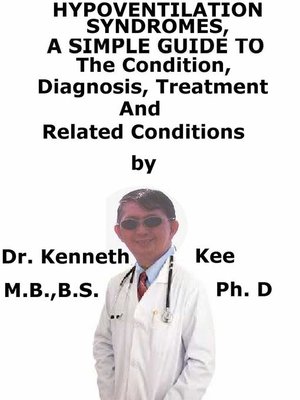Hypoventilation Syndromes, a Simple Guide to the Condition, Diagnosis, Treatment and Related Conditions
ebook
By Kenneth Kee

Sign up to save your library
With an OverDrive account, you can save your favorite libraries for at-a-glance information about availability. Find out more about OverDrive accounts.
Find this title in Libby, the library reading app by OverDrive.



Search for a digital library with this title
Title found at these libraries:
| Library Name | Distance |
|---|---|
| Loading... |
This book describes Hypoventilation Syndromes, Diagnosis and Treatment and Related Diseases
Hypoventilation Syndrome is common in many sedentary and obese people all over the world
Hypoventilation Syndrome or Alveolar hypoventilation is a rare disorder in which a person does not take enough breaths per minute.
The lungs and airways are normal.
Hypoventilation Syndrome (also called Respiratory depression) is a breathing disorder characterized by slow and ineffective breathing.
By definition it causes a higher concentration of carbon dioxide (hyper-capnia) and respiratory acidosis.
Hypoventilation is not the same as respiratory arrest, in which breathing ceases completely and death happens within minutes due to hypoxia and leads rapidly into complete anoxia.
Hypoventilation can be a precursor to hypoxia and its lethality is due to hypoxia with carbon dioxide toxicity.
When someone is suffering from respiratory depression (also known as hypoventilation), the amount of air that they breathe in (tidal volume) is not enough to allow for normal gas exchange to take place, leading to a higher level of CO2 and lower level of O2 in the body.
The higher level of CO2 leads to a state of more acidic blood which can cause any number of body systems to fail.
During hypoventilation, the body cannot adequately remove carbon dioxide.
This can lead to poor use of oxygen by lungs.
The result is a higher level of carbon dioxide and too little oxygen available to the body.
Hypoventilation is different from hyperventilation.
Hyperventilation is when the patient breathe too quickly, lowering levels of carbon dioxide in the blood.
Possible causes of hypoventilation are:
1. Neuromuscular diseases (cause weakening of muscles that control breathing)
2. Chest wall deformities (interfere with the ability to inhale and exhale)
3. Severe obesity (causes the body to work harder to breathe)
4. Brain injury (interferes with the brain's ability to control basic functions like breathing)
5. Obstructive sleep apnea (collapses airway during sleep)
6. Chronic lung disease (describes conditions like COPD and cystic fibrosis that lead to blocked airways)
7. Stroke in the brainstem or other brainstem injuries (the brainstem is essential for breathing control)
8. Congenital central hypoventilation syndrome
9. Smoking tobacco can also lead to narrowing or inflammation of the airways, which in turn could cause hypoventilation
10. Hypo-capnia- a condition of low CO2 in the blood.
CO2 is released during exhalation so the body automatically slows breathing to conserve CO2
11. Chronic mountain sickness (an illness acquired from living at high altitudes)
12. Morbid obesity
Hypoventilation can also occur as a side effect of certain medications.
Large doses of central nervous system depressant drugs may slow down the respiratory system.
Symptoms are:
1. Bluish coloration of the skin caused by lack of oxygen
2. Daytime drowsiness
3. Fatigue
4. Morning headaches
5. Swelling of the ankles
6. Waking up from sleep without sufficient rest
7. Waking up many times at night
Diagnosis:
Blood gases measure the amount of carbon dioxide and oxygen, and the acid/base balance in the bloodstream
Chest x-ray or CT scan: imaging test that checks for abnormalities of the chest
Treatment
Hypoventilation Syndrome is a treatable condition.
1.A new respiratory stimulant drug called BIMU8 is being studied which is considerably more effective
2.Mechanical devices that help breathing may be useful (CPAP).
3.Oxygen treatment...







